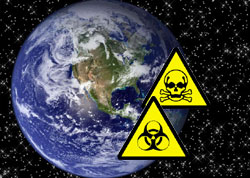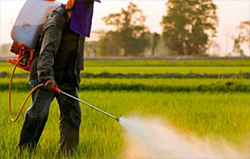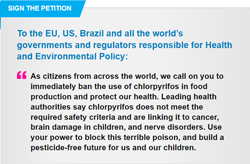 |
|
|
|
US/UK Trade Deal talks presurrising UK to DROP ALL EU standards 1 out of 3 grapefruits and lemons, 1 out of 4 oranges and mandarins, and 1 out of 20 apples, peaches and pears are contaminated
The pesticide industry has a lot to answer for, given the fact that so many products on the market are then later found to be a major cause of ill-health in humans, not to mention to animals and insects they are not intended to target; and the millions of pounds spent by manufacturers in courts, claiming their product is safe! Whilst a lot of attention is rightly given to the deaths of Bees on a massive scale, the toll on human health is often ignored. One of the most dangerous chemicals used as a pesticide in agriculture is Chlorpyrifos, and it remains present in the food on sale in supermarkets of the EU and the UK. In June this year, a series of investigative articles highlighted that the previous European market approval process of chlorpyrifos ignored hundreds of independent studies that showed evidence of how this chemical can harm our brains. The investigation also found that the EU approval relied on a single biased industry study for assessing neurotoxic effects. In August, the EFSA (European Food Safety Authority) subsequently issued a statement saying that the pesticide chlorpyrifos does not meet the criteria required by legislation for the renewal of its approval in the European Union: “The approval period for chlorpyrifos expires in January 2020, and the manufacturers’ application for renewal is currently being evaluated under the EU’s peer review system for approval of pesticides.
In their leaflet available to download from the E-Library (Search Cat: Food)they explain the chemical make-up of the pesticide and how it works: Chlorpyrifos is a typical broad-spectrum, chlorinated organophosphorus insecticide, which kills insects upon contact by affecting the functioning of the nervous system. Organophosphorus pesticides (OPs), including insecticides such as chlorpyrifos operate by blocking the functioning of an enzyme (acetylcholinesterase) that breaks down a specific neurotransmitter, (called acetylcholine). Acetylcholine is responsible for passing impulses from one nerve cell to the other throughout the nervous system. The accumulation of acetylcholine in the neuron junctions (synapses) of the insects causes increased transmission of nerve impulses and an over stimulation of the nerve cells, which leads to neural toxicity and eventually death. Chlorpyrifos, a developmental neurotoxic pesticide, is one of the most commonly used insecticides in Europe. Yet increasing evidence links it with serious health conditions including disruption of the hormonal system and impacts on children’s brain development.
• Decreased IQ In the UK in April 2016, the HSE banned the use of the pesticide other than via a protected brassica seedling drench treatment applied via automated gantry sprayer. Stopping any other form of use such as via hand held sprayers. However this has not gone far enough and campaigners are calling for a complete outright ban of this toxic pesticide. In 2020. Campaign organisation Avaaz says in its latest appeal for support to ban this chemical from sale: “Chlorpyrifos is the chemical industry’s dirtiest secret, topping sales everywhere, but kept from the media spotlight. And it’s no surprise — it traces back to nerve agents developed in a Nazi lab! Now it’s in our food, air and drinking water. But worse is to come for the health of people in the UK. Existing bans on pesticides by the EU and protocols such as REACH, will all be lost as part of any free trade agreement with the US. Leaked documents available from this website's E-Library show the level of pressure being put on the UK Government to drop ALL EU standards. Add too the likes of the ERG and other Tory MPs and party members, pushing for a complete abandonment of any alignment at all with the EU after Brexit, the likelehood of the US getting its way; is pretty high. More info:
Source: Avaaz / EFSA / HEAL / The Guardian / Open Democracy |

 Given the level of chemicals present in our food and used to grow it in the first place, many of which are carcinogenic (cancer causing) and toxic to human health; it is no wonder that our health and that of our children is being compromised by illnesses and diseases that can be avoided.
Given the level of chemicals present in our food and used to grow it in the first place, many of which are carcinogenic (cancer causing) and toxic to human health; it is no wonder that our health and that of our children is being compromised by illnesses and diseases that can be avoided. Brussels based leading not-for-profit organisation, Health and Environment Alliance issued a leaflet in August 2018, which argues for the ban of this highly dangerous pesticide which is based on a nerve agent developed by the Nazis in the 1940s.
Brussels based leading not-for-profit organisation, Health and Environment Alliance issued a leaflet in August 2018, which argues for the ban of this highly dangerous pesticide which is based on a nerve agent developed by the Nazis in the 1940s. 